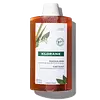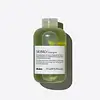What's inside
What's inside
 Key Ingredients
Key Ingredients

No key ingredients
 Benefits
Benefits

 Concerns
Concerns

 Ingredients Side-by-side
Ingredients Side-by-side

Water
Skin ConditioningDisodium Laureth Sulfosuccinate
CleansingDecyl Glucoside
CleansingLauryl Betaine
CleansingCeteareth-60 Myristyl Glycol
EmulsifyingLactic Acid
BufferingPentylene Glycol
Skin ConditioningAlpinia Galanga Rhizome Extract
Skin ConditioningParfum
MaskingLaureth-3
EmulsifyingMaleic Acid
BufferingMaltodextrin
AbsorbentOleth-10
EmulsifyingPolyquaternium-22
CI 17200
Cosmetic ColorantSodium Benzoate
MaskingSodium Chloride
MaskingSodium Hydroxide
BufferingTocopherol
AntioxidantWater, Disodium Laureth Sulfosuccinate, Decyl Glucoside, Lauryl Betaine, Ceteareth-60 Myristyl Glycol, Lactic Acid, Pentylene Glycol, Alpinia Galanga Rhizome Extract, Parfum, Laureth-3, Maleic Acid, Maltodextrin, Oleth-10, Polyquaternium-22, CI 17200, Sodium Benzoate, Sodium Chloride, Sodium Hydroxide, Tocopherol
Water
Skin ConditioningSodium C14-16 Olefin Sulfonate
CleansingSodium Lauroyl Methyl Isethionate
CleansingCocamidopropyl Betaine
CleansingSodium PCA
HumectantDecyl Glucoside
CleansingDisodium Coco-Glucoside Citrate
EmulsifyingSodium Methyl 2-Sulfolaurate
CleansingLauramidopropylamine Oxide
CleansingCoco-Glucoside
CleansingGlyceryl Oleate
EmollientPanthenol
Skin ConditioningBenzyl Alcohol
PerfumingParfum
MaskingSodium Chloride
MaskingPolysorbate 20
EmulsifyingSodium Methyl Isethionate
EmulsifyingSodium Benzoate
MaskingCitric Acid
BufferingLauric Acid
CleansingDisodium 2-Sulfolaurate
CleansingMyristamidopropylamine Oxide
CleansingPolyquaternium-7
Trisodium Ethylenediamine Disuccinate
Guar Hydroxypropyltrimonium Chloride
Skin ConditioningTetrasodium Glutamate Diacetate
Sodium Laurate
CleansingCucumis Melo Fruit Extract
Skin ConditioningCI 19140
Cosmetic ColorantCI 61570
Cosmetic ColorantCI 14700
Cosmetic ColorantWater, Sodium C14-16 Olefin Sulfonate, Sodium Lauroyl Methyl Isethionate, Cocamidopropyl Betaine, Sodium PCA, Decyl Glucoside, Disodium Coco-Glucoside Citrate, Sodium Methyl 2-Sulfolaurate, Lauramidopropylamine Oxide, Coco-Glucoside, Glyceryl Oleate, Panthenol, Benzyl Alcohol, Parfum, Sodium Chloride, Polysorbate 20, Sodium Methyl Isethionate, Sodium Benzoate, Citric Acid, Lauric Acid, Disodium 2-Sulfolaurate, Myristamidopropylamine Oxide, Polyquaternium-7, Trisodium Ethylenediamine Disuccinate, Guar Hydroxypropyltrimonium Chloride, Tetrasodium Glutamate Diacetate, Sodium Laurate, Cucumis Melo Fruit Extract, CI 19140, CI 61570, CI 14700
 Reviews
Reviews

Ingredients Explained
These ingredients are found in both products.
Ingredients higher up in an ingredient list are typically present in a larger amount.
Decyl Glucoside is a glucose-based surfactant and emulsion stabilizer. It is created by reacting glucose with the fatty acids from plants.
Surfactants help clean the skin by trapping oil, sebum, and dirt to be washed away. As an emulsion stabilizer, it stabilizes the ingredients in a product by preventing them from separating.
This ingredient is biodegradable and non-toxic. This ingredient is commonly found in baby shampoos.
Decyl Glucoside is sometimes used to stabilize the UV filter Tinosorb.
Learn more about Decyl GlucosideParfum is a catch-all term for an ingredient or more that is used to give a scent to products.
Also called "fragrance", this ingredient can be a blend of hundreds of chemicals or plant oils. This means every product with "fragrance" or "parfum" in the ingredients list is a different mixture.
For instance, Habanolide is a proprietary trade name for a specific aroma chemical. When used as a fragrance ingredient in cosmetics, most aroma chemicals fall under the broad labeling category of “FRAGRANCE” or “PARFUM” according to EU and US regulations.
The term 'parfum' or 'fragrance' is not regulated in many countries. In many cases, it is up to the brand to define this term.
For instance, many brands choose to label themselves as "fragrance-free" because they are not using synthetic fragrances. However, their products may still contain ingredients such as essential oils that are considered a fragrance by INCI standards.
One example is Calendula flower extract. Calendula is an essential oil that still imparts a scent or 'fragrance'.
Depending on the blend, the ingredients in the mixture can cause allergies and sensitivities on the skin. Some ingredients that are known EU allergens include linalool and citronellol.
Parfum can also be used to mask or cover an unpleasant scent.
The bottom line is: not all fragrances/parfum/ingredients are created equally. If you are worried about fragrances, we recommend taking a closer look at an ingredient. And of course, we always recommend speaking with a professional.
Learn more about ParfumSodium Benzoate is a preservative. It's used in both cosmetic and food products to inhibit the growth of mold and bacteria. It is typically produced synthetically.
Both the US FDA and EU Health Committee have approved the use of sodium benzoate. In the US, levels of 0.1% (of the total product) are allowed.
Sodium benzoate works as a preservative by inhibiting the growth of bacteria inside of cells. It prevents the cell from fermenting a type of sugar using an enzyme called phosphofructokinase.
It is the salt of benzoic acid. Foods containing sodium benzoate include soda, salad dressings, condiments, fruit juices, wines, and snack foods.
Studies for using ascorbic acid and sodium benzoate in cosmetics are lacking, especially in skincare routines with multiple steps.
We always recommend speaking with a professional, such as a dermatologist, if you have any concerns.
Learn more about Sodium BenzoateChances are, you eat sodium chloride every day. Sodium Chloride is also known as table salt.
This ingredient has many purposes in skincare: thickener, emulsifier, and exfoliator.
You'll most likely find this ingredient in cleansers where it is used to create a gel-like texture. As an emulsifier, it also prevents ingredients from separating.
There is much debate on whether this ingredient is comedogenic. The short answer - comedogenic ratings don't tell the whole story. Learn more about comegodenic ratings here.
The concensus about this ingredient causing acne seems to be divided. Research is needed to understand if this ingredient does cause acne.
Scrubs may use salt as the primary exfoliating ingredient.
Learn more about Sodium ChlorideWater. It's the most common cosmetic ingredient of all. You'll usually see it at the top of ingredient lists, meaning that it makes up the largest part of the product.
So why is it so popular? Water most often acts as a solvent - this means that it helps dissolve other ingredients into the formulation.
You'll also recognize water as that liquid we all need to stay alive. If you see this, drink a glass of water. Stay hydrated!
Learn more about Water